From Newbie to Biologist: Browsing the World of Newbie Gardening
Wiki Article
From Amateur to Environment-friendly Thumb: A Step-by-Step Journey Via the Art of Gardening

Understanding Your Horticulture Space
To start your horticulture trip, it is important to comprehend the distinct characteristics and constraints of your horticulture area. Take a minute to observe your surroundings. Is your area little or huge? Is it exposed to full sun or does it receive partial color? Exist any type of specific challenges you may deal with, such as bad dirt high quality or restricted water schedule? Understanding these aspects will help you make educated choices about the kinds of plants that will prosper in your space.Take into consideration the size of your horticulture area. If you have a small room, you might require to concentrate on container horticulture or upright gardening to maximize your growing location. On the other hand, if you have a large space, you have the luxury of growing a variety of plants and producing different areas within your yard.
Next, assess the quantity of sunlight your room receives. This will certainly figure out which plants will certainly thrive and which ones might have a hard time. If your area is shaded, you can decide for shade-loving plants like hostas or brushes. If your area gets complete sun, you can expand a variety of plants, consisting of natural herbs, blossoms, and vegetables.
Lastly, think about any restrictions or difficulties certain to your area. If your soil quality is bad, you may require to modify it with garden compost or pick plants that are tolerant of less-than-ideal conditions. If water is limited, you can select drought-tolerant plants or implement water-saving strategies like mulching.
Choosing the Right Plants for Your Yard
Select plants that are appropriate to your yard's one-of-a-kind conditions and your personal choices. When picking plants for your yard, it is vital to consider aspects such as sunshine, dirt kind, and climate. Some plants favor well-drained soil, while others flourish in damp or clay-like dirt.It's also worth considering the maintenance level of the plants you select. Some plants need more care and attention, while others are more low-maintenance.
Preparing the Soil for Growing
First, evaluate the condition of your soil to identify if any improvements or amendments are needed. The quality of your dirt is critical for the success of your yard. Begin by inspecting the appearance of the dirt. Is it sandy, fertile, or clayey? Sandy soil drains promptly, while clayey dirt maintains water. Loamy dirt pop over to this web-site is the suitable equilibrium between the 2. Next off, inspect the pH level of your soil. Many plants prefer a somewhat acidic to neutral pH, around 6.0 to 7.0. You may need to readjust it using soil amendments such as lime or sulfur if your dirt is too acidic or alkaline. In addition, you must think about This Site the nutrient material of your dirt. Conduct a dirt test to establish if any type of essential nutrients are doing not have. This will aid you choose which plant foods or raw material to add. Ensure that your soil is well-draining. Poorly drained pipes dirt can cause water logged roots and other plant wellness problems. If essential, enhance water drainage by adding raw material like garden compost or peat moss. By examining and making essential amendments to your dirt, you can develop an optimal atmosphere for your plants to thrive.Nurturing and Keeping Your Yard
Make certain to sprinkle your plants deeply, permitting the water to pass through the dirt and get to the roots. Normal weeding is likewise important to keep your yard free from unwanted plants that complete for nutrients and space. Consistently check your plants for any kind of indications of invasion or health problem and take prompt activity to avoid more damages.Troubleshooting Common Gardening Issues
To resolve usual gardening problems, beginning by determining the issue and taking prompt activity. One of one of the most typical problems garden enthusiasts face is pests. You might have a pest infestation if you see eaten fallen leaves or plants that are wilting for no evident reason. Inspect your plants carefully for indicators of insects or various other bugs. Eliminate them by hand or make use of organic bug control techniques if you identify any type of. An additional usual trouble is vitamins and mineral deficiency. They may not be getting adequate nutrients if your plants have yellow or discolored leaves. Consider feeding your soil or including compost to improve its find more nutrition material. Overwatering is another problem that can hurt your plants. You may be overwatering if you see water logged soil or wilting regardless of adequate watering. Readjust your watering timetable accordingly and ensure proper drain. Disease can likewise affect your garden. It could be an indicator of illness if you see spots, mold, or unusual growth on your plants. Eliminate influenced plants and treat the continuing to be ones with organic fungicides or chemicals. By without delay dealing with these common issues, you can make certain the health and wellness and success of your garden.Final Thought
Congratulations! You have actually efficiently finished the journey from beginner to environment-friendly thumb in the art of horticulture. By recognizing your horticulture room, selecting the right plants, preparing the soil, and nurturing your garden, you have actually gotten over typical gardening problems like a pro. Currently, armed with understanding and experience, you prepare to take pleasure in the beauty and wealth of your growing garden. Maintain the wonderful job and remain to cultivate your eco-friendly thumb!
When choosing plants for your garden, it is crucial to think about aspects such as sunlight, soil kind, and environment. Some plants like well-drained dirt, while others prosper in clay-like or wet soil (newbie gardening). By understanding your horticulture area, selecting the right plants, preparing the soil, and supporting your yard, you have overcome typical horticulture problems like a pro
Report this wiki page